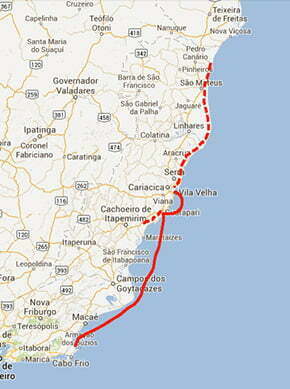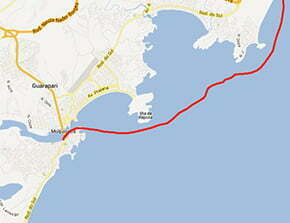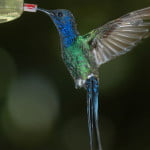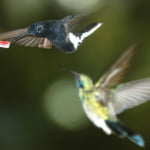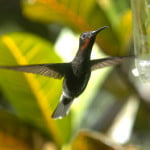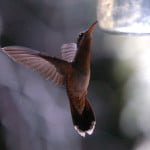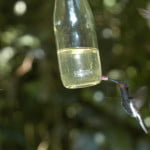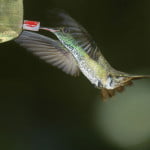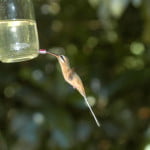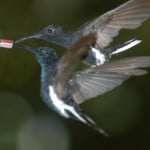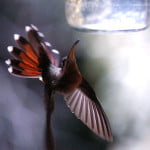Wednesday, 19 – 04 – 2006.
We arrived in the Southeast where some of Brazil’s richest and most crowded states are and that’s what this coastal zone shows. The occupation of this part of the coast started earlier than in the rest of the country. This occurred at the end of the 60’s and it increased during the 70’s. This period of our recent history was known as the “Brazilian miracle” during which wealthy people from Rio and São Paulo had plenty of money to build their summer houses, especially at São Paulo’s north coast beaches as well as on Rio de Janeiro’s coast. At the same time, the São Paulo – Rio de Janeiro coastal road was inaugurated, BR 101, without any previous occupational planning. The result was “wonderful”! Mangrove areas were filled with earth and covered with asphalt, the slopes of Serra do Mar were occupied; deluded fishermen sold their properties for nothing. And thus started the slum process as well as a greater exclusion compared to the period during which they were simply non-industrial fishermen. The tiny and simple houses were replaced by mansions and “high standard resting refuges”. Walls were built to protect these properties, consequently they block the view of the sea from some angles and sometimes some beaches started a process of privatization remaining public despite everything. More recently condominiums have emerged like harmful grass. Real estate speculation reigned all the time. Suddenly, thousands of people started to go to the coast not only on vacation periods, but also on week-ends and holidays. Although it may seem curious, as I have already said in my logbooks, a study shows that the sea is a leisure area for Brazilian people. That’s where they go on week-ends to swim, for nautical sports, to drink beer and see beautiful women, nothing else. During this wealthy period of expansion, the ecological awareness in regard to the importance of the sea for the climate and the biodiversity of the planet was very little or hadn’t even come to existence and the infrastructure which is required to receive tourists and summer visitors was not good enough. Far from it. As usual, the public administration was late and unable to anticipate or follow the change. Today, in general, there is a huge deficit in regard to the waste treatment system as well as the garbage collection in most districts of the coastal zone. Most of the time all the dirt goes to the sea “in natura” thus contributing to turning the maritime space into the litter of humanity as it has always been the case. At the beginning of the seventies, most beaches received hotels and pousadas. Today, most of them have resorts, especially in Angra dos Reis’ Bay, in Rio de Janeiro. Since this area is highly industrialized and rich, four out of the five biggest national ports are in these states: Santos and São Sebastião, in São Paulo; Sepetiba, in Rio de Janeiro; and Tubarão, in Vitoria. That’s quite a lot. As you can see there is a lot of pressure too. Little by little we discover another one of Brazil’s regions; by exploiting it and describing our impressions. However, since everything has a starting point, in regard to the Southeast, when you come from the north, like us, this point is the state of Espirito Santo.
There are approximately 400 kilometers along the coastal zone with a great variety of natural scenery. It is an area of transition which “inherits some features from Bahia in the North and others from Rio de Janeiro in the South”, according to professor Jacqueline Albino who teaches Coastal Morphology and Processes at Espirito Santo’s Federal University, UFES. That’s why, she says, on Espirito Santo’s north coast you can find an area of live crags like those of the south of Bahia. Near Vitoria as well as along the way to Guarapari, crystalline rocks are predominantly found. They are typical in Rio de Janeiro like Pão de Açucar’s.
Likewise, according to oceanographer Agnaldo Martins, Espirito Santo’s seas have subtropical features in the south and tropical in the north.
Statistics show that there are between 8 and 10 thousand fishermen in this state, divided into 45 communities. Most of them are non-industrial fishermen and there are three different types of activities: from the lobster fishing with drag-nets (a fleet of approximately 300 boats) to trawl-net fishing or the line fishing in Abrolhos ( grouper, cioba, serranoid fishes, etc.). There are also a few industrial fishing communities in specific areas which we will be visiting soon. According to the professor, altogether they remove from the sea about 20 thousand tons of fishes per year. In spite of this figure, fishing is not a very important activity for the state economy especially because most of them are non-industrial fishermen whose income is not very significant in regard to the income collected in the state. We will talk about this subject later. Today, we have just mentioned some of the aspects we will deal with. Tomorrow we will see this information more in detail.
Thursday, 20 – 04 – 2006.
One of the issues in Espirito Santo that calls our attention the most, which attracts environmentalists and the media, is eucalyptus reforestation. This is due either to the existing legends of this tree from Australia, or to abuses practiced in the seventies when the army encouraged this type of plantation and a significant part of the Atlantic Forest was devastated, or recent irresponsible and illegal actions carried out by MST and Via Campesina’s vandals. As you all know, Aracruz Celulose’s research station has been recently invaded and destroyed in Rio Grande do Sul. On that occasion, João Pedro Stedile (received a couple of times in the President’s office, and on one of these occasions a picture of Lula was taken with the famous red cap on, the symbol of the movement), one of the leaders declared that “he congratulated his fellows on calling the society’s attention.” This was evident proof of his disregard for democracy and the rule of law. During the same period of time, another leader, Jaime Amorim, in view of the desperate cry of the person in charge of the research who had lost years of her work with the barbaric act, he dared to say: “If she were a serious researcher, she wouldn’t have sold herself to multinational companies.” Another statement was added to this festival of insanities when Stedile repeated the well known cliché according to which “the cellulose industry creates green deserts with eucalyptuses.” Obviously, the media reproduced these statements. That’s it! And that’s what they say in the Northeast. Nothing else is necessary in this disinformation tournament in which we live. This is the reason why this and other legends on the eucalyptus are spread.
This is also the reason why before going to Vitoria we tried to interview a professor from USP, University of São Paulo. Since he is from São Paulo, he couldn’t be blamed for being influenced by Espirito Santo’s public administration or by companies which operate in the reforestation of Espirito Santo where the eucalyptus culture represents 21% of the gross domestic product. Actually, we had a private lesson with Professor Gregorio Ceccantini, an expert in vegetal anatomy from USP’s Botany Department. And he made comments on all the myths concerning the reforestation based on eucalyptus.
I started with the “green desert” issue. And here is the answer: “Every time man simplifies a vegetal area, the same occurs with animal life.” In other words “the homogeneity of the system does not accept a great diversity of occupants.
He went on explaining that the way the trees are planted, one next to the other, so that insolation affects practically only the crown of the trees (facilitating both the handling and the cut), the trunks are extremely flat and straight, with no forks which affects nesting. Consequently, there is a decreasing number of mammals, however “there is a diversity of invertebrates, insects and micro-organisms. It is not a desert.” Additionally, this decreasing factor occurs in any monoculture, eucalyptus is not worse than the others. Professor Gregorio Ceccantini said that this type of tree requires less defensives and pesticides since it is a strong, rustic plant which survives in a poor and arid soil as it is the case in Australia. Normally, the soil is only treated with lime to diminish the pH level. In this regard the eucalyptus is better than many other monocultures.”
According to Professor Gregorio Ceccantini part of the bad reputation of the eucalyptus results from the period during which the army encouraged the reforestation of the country. “At that time, in the 70’s, without today’s environmental awareness, great areas of native forest were devastated for reforestation, which is obviously absurd.”
In fact, this issue affects not only this area but also other states such as Sergipe and Alagoas. Do you want to know where? Well, this is just one of the problems of the obstructed mouth of the São Francisco River where we have recently been. Many of its affluents in Minas Gerais had their ciliary forests devastated whereas fields, bogs and lowlands were occupied by eucalyptus plantations in the seventies. Today these areas are completely devastated and abandoned.
According to Gregorio, “this is not the rule of the present plantation.”
We mentioned the employment issue and the professor agreed that the eucalyptus generates a great number of employments seeing that vast areas are always mechanized, use high technology and “as all the other monocultures this one doesn’t need much labor force.” He made a joke saying that the only culture that generates lots of employment is the sugar-cane “since it still uses medieval methods.”
Then we made comments on positive aspects of this plantation, and he reminded us of the fact that reforestation removes the pressure existing on native forest.” He mentioned the great demand for wood and its byproducts in several daily activities such as toilette paper, notebooks, or wood used in ovens at pizza places and at the baker’s; besides furniture, light posts, charcoal, etc. Heavy industry turns eucalyptus into vegetal charcoal which is used in steel companies to manufacture steel and alloys of iron. It is also used in perfumes, cosmetics and medicines. “The Brazilian steel owes a lot to eucalyptus since it is purer than that from abroad which uses mineral charcoal and leaves residues, “he added.
Finally, we will find out more about cellulose itself. According to former Minister Maílson da Nóbrega (O Estado de S. Paulo, 26 – 03 – 2006), “the internet and the information technology opened a new world for short fiber cellulose. Now, when it is printed, the information is generated beside the computer. The consumption of paper with good absorption of ink and toner has increased a lot. The short fiber is adequate. Brazil tends to be the world’s greatest cellulose manufacturer (today it is the fifth).”
I read on the internet studies for and against the eucalyptus. I will mention a few data given by ABRAF (Brazilian Association of Planted Forest Producers): Brazil consumes about 300 million cubic meters of wood per year, and just one third comes from planted forests; this sector gives employment to two million Brazilians directly and indirectly, selling 21 billion dollars per year, which corresponds to 4% of the gross domestic product. Today we have about five million hectares of planted forests and there is an intention to reach eleven million hectares. Just for comparison purposes, soy covers 60 million hectares.
At last, according to ABRAF, the right thing to do is to plant in appropriate places and there are plenty of them in the country. ABRAF believes today we have 90 million hectares of deforested areas or 900 thousand square kilometers of devastated land.” That’s where plantation is suggested.
I can only understand all this debate because of past mistakes, some of them here where we are. Espirito Santo has about 250 thousand hectares of planted forests. A significant part belongs to Aracruz Celulose. Now the state is planning to increase this area to 600 thousand hectares. And this made environmentalists angry as well as leftists, the church, unionists, political parties, etc.
We will see the occupation “in loco”. We rented a car to drive to the border of Bahia, in Riacho Doce. There are just a few sheltered bays to anchor the Endless Sea on Espirito Santo’s north coast, that’s why we chose the car. One of the possible places would be the Doce River, but according to the information I got it is obstructed and its bar is full of sand banks. After the experience in the Jequitinhonha, I don’t even think in repeating it. It is safer to go by car. We will start our trip tomorrow. Then I’ll see what they have done. I will return afterwards to report it.
Friday, 21 – 04 – 2006.
We left Vitoria Yacht Club early and drove about 300 kilometers always northwards where there is a concentration of reforestation areas. We intended to go to the border of Bahia and then go down stopping at the beaches and coastal communities to shoot the occupation.
We arrived in Riacho Doce at the beginning of the afternoon. Our last kilometers were unpaved since there is asphalt only until Barra da Conceição (Espirito Santo’s infrastructure, compared to the biggest states of the Northeast, such as Bahia and Ceara, is far from being good). From there we took a small road which leads at first to Itaunas, a small town which still preserves the original design of Jesuits, the square shape, with a church at one end and houses around it. We could see again nature’s answer to the bad use of the land. The old settlement of fishermen was covered by dunes which are up to 30 meters high and it had to be removed. The vegetation that fixed them was so frequently cut that the sand of the dunes buried them, according to Professor Jacqueline Albino.
We left the car to shoot the ruins of the original church which is almost completely buried today. Afterwards we went to the border. First the road passes behind the sand mountains, then we entered in an area which was flooded on one side and there was shoal on the other. The sea was a little bit further on. The road is quite beautiful; sometimes the Atlantic Forest trees on both sides form such thick tunnels that one can hardly see the sun. Suddenly, after a curve, we saw something astonishing: we went from a vigorous forest to Aracruz’ huge and monotonous reforestation area. We were shocked by the sudden change, from the remaining Atlantic Forest to the eucalyptus. But they were there, one next to the other, like neighbors fighting. Later, I found out that the eucalyptuses cover about 50 thousand hectares just at the north end of the state where there used to be a wonderful forest before.
In Riacho Doce, the last village before the border, there is almost nothing. Only 15 houses where local fishermen live, one far from the other, and a restaurant where food from Minas is offered on the river bank which is the border between the two states. Bahia is on the other bank. Talking to people, I was told again what some biologists and environmentalists have already told me. Aracruz doesn’t buy more properties, but it “encourages” the eucalyptus plantation by giving cuttings to small farmers, advising them how to plant and promising to buy their production later. The worse thing is that this whole area is part of Itaunas State Park inaugurated in 1991, when there was almost nothing to preserve. Most of the native forest had been replaced by eucalyptuses or pasture. One more time the ineffectiveness of the agencies that should take care of our environment is evident. According to the act 9.985/2002 which established the National System of Conservation Units (SNUC) and Conama’s determination 013/90, planting eucalyptus in the surrounding area of these unites is forbidden. The Federal Public Prosecution Service (which is an act of law contrary to Conama’s Resolutions) was clear in regard to the prohibition in a ray of 10 kilometers from the UCs (conservation units). But sometimes the distance is not longer than 10 meters! All right, the area that I visited on the border with Bahia corresponds to an old reforestation from the 60’s, 70’s. But today’s are not very different.
Then why turning into reserves where there isn’t any special “reserve”? Here is another repeated mistake (especially in Bahia, but not only); that of turning the entire coast into APAs, Parks, Reserves, Ucs; sometimes where there is nothing to be preserved. They have something in common: most of them have no infrastructure at all. Thus the state administration trivializes and brings discredit not only to these areas but also to its own power. At the same time, I could understand during my visit what opposes big wood producers and Espirito Santo’s authorities to environmentalists, class associations, small extraction communities, journalists, etc…
The thing is that when reforestation companies were established, they made a bad choice in regard to the lots (this is something that still occurs; in 2005 Bahia’s Ibama fined Veracel – 50% of its stocks are Aracruz’ – R$ 360 thousand for making it difficult the natural regeneration of the state’s Atlantic Forest). Most of them are on the coast, some in plateaus where the Atlantic Forest was before. There is also the fact that chlorine is used in the paper bleaching process, a toxic product that pollutes the water of the rivers. From 1990 on, Aracruz started to process a small part of its cellulose production without using chlorine since this was required by countries which were buying the product, such as Germany. The company still has many ports on Bahia and Espirito Santo’s coast from where the wood is transported. And at least one of them was fined by Ibama due to oil leakage (below the mouth of the Jequitinhonha River). Environmentalists also complain about the pressure put by huge barges with eucalyptus navigating in the area of Abrolhos, a fragile ecosystem which is on the way between the ports of the company.
Additionally, Aracruz has enormous sales revenues which obviously call people’s attention. This means a tough fight.
In Vitoria, we talked to Professor Luis Fernando Schettino who teaches Ecology and Natural Resources at Espirito Santo’s Federal University. He was the secretary of Espirito Santo’s Environment Department during Governor Vitor Buaiz’ administration in 1995 as well as in 2003 and 2004 during Paulo Hartung’s administration. According to Schettino, Espirito Santo’s whole surface is 4,5 million hectares and “just a little bit more than 200 / 250 thousand hectares are covered by eucalyptuses.” He said that the state of ES lost his vegetal coverage, which is the Atlantic Forest, especially in the 60’s and 70’s, “more specifically to satisfy Rio de Janeiro’s civil building spree.” Afterwards, the devastation process was encouraged by the army authorities and their tax incentive policy in regard to reforestation. This made the native forest decrease even more “and it was legally supported at that time.” All this created the debate on eucalyptuses.
According to Schettino, the eucalyptus reputation of “absorbing water” is false. He explained to us that the eucalyptus root is huge, reaching up to 12 meters and covering swampy areas which are consequently drained; making us believe that the eucalyptus turn them into dry areas. However, the cuttings used for wood production purposes are cloned, “these roots don’t reach more than one meter and a half, besides they shouldn’t be planted in permanent preservation areas.” Schettino doesn’t recommend the eucalyptus in areas where other cultures are possible. Nevertheless, he encourages this type of plantation in devastated areas and believes that it wouldn’t be too much to cover 600 thousand hectares in the state of ES with it, instead of the 250 thousand it covers today. He reminds us of the fact that Espirito Santos’s pasture covers one million eight hundred thousand hectares.
And you, what do you think?
Obviously, seeing huge coastal areas covered with eucalyptuses shocks us. But apart from that, ES’ north end beaches are practically unoccupied. Normally, they are long and narrow. Some of them are over 10 kilometers long with no obstacle. Long straight beaches covered with white sand and weak waves. At least those from the border with Bahia to Conceição da Barra. Tomorrow we will see an erosion process which is present all over the city and we will also talk to non-industrial fishermen about ES’ government fostering the shrimp fishing which failed. We arrived late in the evening in Conceição da Barra. We had a very good dinner at Abrolhos restaurant and went to a Mineiros’ pousada next to it.
Saturday, 22 – 04 – 2006.
In the morning, we walked along Conceição da Barra to see the erosion in the district. I decided to go to a fishermen’s place to ask about it. I met one of them who had seen all the process due to his age. Seu Napoleão, a fisherman, in a simple and humble manner told us many problems. The ciliary forest alongside the Cricaré River which flows in the city was cut. It was replaced by plantations which started to obstruct the river. At the same time, a sort of peninsula moves forward into the sea forming one of the banks of the bar. Today it is occupied by local inhabitants and many houses were built where there were lots of coconut trees before. As time went by, the various city administrations didn’t care about the first signs of excavation and the inhabitants continued to occupy the area without any previous exam. The sidewalks which had been made to urbanize the shore collapsed. The sea started to penetrate into the continent. Streets were flooded, the walls of the houses collapsed as well as the Lighthouse of the city. Approximately 200 houses were swallowed by the sea. Today, the bar is so low that the fishing boats can’t enter or leave it easily.
In Vitoria, we interviewed Professor Jacqueline Albino who teaches Coastal Morphology and Processes at ES’s Federal University, she insisted on the idea that ES’s coast has a deficit of coastal sediments (that is sand). As it has already been said, most beaches here are quite narrow; consequently, they are more fragile than usual. Maybe this is one the reasons why it is so. Anyway, nobody has a conclusive explanation far that. Erosion continues to make parts of land collapse affecting streets and avenues; which means that more houses are about to be swallowed too. I asked Jacqueline if there had been any interference on the coast near the city. Negative answer. Usually, this causes erosion. The coastal zone and its peculiar dynamic don’t stand man’s interference; therefore, it always reacts. However, this is not the case here. Maybe it is just the fact of having cut the vegetal cover which resulted in the obstruction of the river. It may also be a mystery which is not yet known. We hope the origin can be found out before Conceição da Barra moves to another place like Itaunas.
In spite of all the evidences, the state government invested in shrimp trawl-net fishing. It failed. Any doubts it was a failure? Shrimp fishing requires a fleet of boats. If you want to succeed, besides shrimps, the sea must be deep enough so that the boats enter and leave the bar. This is not the situation here.
We went towards Regencia on the banks of the Doce River, ES’s most important river. We intended to visit one more Tamar’s base which is on Comboios beach, the only place where the biggest maritime turtles spawn in Brazil. On the way we passed São Mateus and visited the old river port on the banks of the Cricare River. A beautiful place with a Fountain Square and the well preserved original settlement around it. However, the port itself exists only in the memory of the older. Only small canoes are deep enough to navigate in it.
As I go down the Brazilian coast it is more evident to me that maybe the only river which is not obstructed is the Amazon. It is a pity. “Rivers are a life source”, this is what was written on plaques I saw in Oiapoque up in the North at the border with the French Guyana…
On the road again. We will go now to the district of Linhares which is 150 kilometers in the south at the border with Bahia.
On our way we only saw pastures for cattle and reforested areas with eucalyptuses. Even the hills are naked. When we were about to arrive, we saw two Atlantic Forest’s reserves, the only reserves left in the state. We couldn’t resist. We stopped and went there to see how the forest which covered ES was like.
Sooretama Biological Reserve has 24 thousand hectares and it is kept by the state government. It is a full protection conservation unit. Fortunately, human interference is as little as possible in this type of reserve. This is the reason why a few centennial trees can be found, all of them threatened with extinction such as jacaranda-da-bahia, quixabeira, jequitiba, ipe and canela. On these trees, there are macucos, mutuns, papagaios-chaua as well as many other birds which are also threatened with extinction.
A little bit further on, we stopped in another reserve, a private one, kept by Companhia Vale do Rio Doce. There are over 22 thousand hectares of the most beautiful native forest, the Atlantic Forest. But this is the only thing left in ES. Approximately 50 thousand hectares. Just a few tufts spread along the coast. Normally, small shoals, or tiny vegetation islands on Serra do Mar (Sea Mountain Chain). That’s all. This is another clue that helps us understand all the noisy made by journalists and environmentalists in regard to ES’s reforestation.
We arrived in Regencia after midday. It took us too long, especially due to the fact that the coastal road, BR 101, is away from the coast unlike Rio, São Paulo and Northeast’s coastal roads. In ES, the road is about 40 kilometers away from the coast, such as Regencia. We had to take a small unpaved road which runs parallel with the Doce River, always surrounded by cacao farms (the witch’s broom hasn’t arrived yet) or pastures until the sea.
But it was worthwhile. There was a misunderstanding and people from Tamar’s base hadn’t been warned about our trip and nobody in charge was there when we arrived. We were given their addresses in the small town of one thousand five hundred inhabitants. We went there and knocked on Joca’s place front door (Joao Carlos Alciati Thome), and his wife, veterinary Cecilia Baptistotte. We were very well received. This nice couple took us to the base and explained to us all the details of their “modus operandi”. They shared with us the scarce information on the habits of this huge animal reaching up to 600 kilos. There are just a few of them on our coast. Not more than ten. However, they chose Comboios beach to spawn. Joca and Cecilia learnt that these turtles don’t have that hard shell like the others, it is some sort of resistant leather. They dive up to a thousand meters. If they didn’t have this softer “cover”, they wouldn’t be able to go that far due to the extraordinary pressure below the water.
This Tamar’s base dates from the 80’s and it was one of the first established on the Brazilian coast. It is one of the biggest job generators for Regencia’s inhabitants who don’t have many options. In the clothing manufacture they have, the biggest one, about 50 people work to supplement the revenue of their families. T-shirts, caps and other products are made and then sold in many parts of the coast, as we have already mentioned.
After the visit, Joca took us on one of the few boats Ibama has to see the mouth of the Doce River. It is a very beautiful place, but the river … Sand banks have always existed at its mouth, one of the most dangerous on the Brazilian coast. There have always been many shipwrecks in the area, since the Empire times. Today, in addition to these banks, the Doce River is completely obstructed. But there are still fishes in it, especially robalos, to me the best thing from Brazilian waters. I saw several small fishing boats throw their nets where the waves break and fish dozens of them. According to Joca, fishermen respect a closed season of their own; instead of not working for three months, during the mating season, they stop for 15 days and work for 15 days. Ibama shuts its eyes; which is something that I appreciate in this situation, since simply prohibiting is not a good solution. Fishermen agreed in diminishing the number of nets. It is better to accept this proposal. At least there is a decreasing fishing effort and this is what really counts.
Joca started a robalo breeding farm with the natives and showed us the tanks which are ready to receive the first fishes. Excellent! This base is trying to make something by their own in this area which may bring revenue and benefits for local inhabitants, something different from the catastrophic shrimp breeding. I hope they will succeed.
It was dark when we returned to the small port behind Tamar’s headquarters. We said goodbye and continued our trip. This time we took the old road which runs alongside the coast and reminds us of BR 101 on the north coast of São Paulo. But this one is unpaved … We will sleep tonight in Sahy’s Bar (there is one here too, not only that in São Paulo…) at Pousada dos Cocais, suggested by our hosts in Regencia. By the way, it is a beautiful pousada with a remaining shoal around. Discreet enough not to spoil the landscape, it generates jobs and helps local economy. This is an ecological and self-sustainable pousada. This is an example for tourism. It was about time! Tomorrow I will make more comments on this issue on ES’s coast which is far from the devastation caused either by elite tourism (resorts), or mass tourism in the Northeast.
Sunday, 23 – 04 – 2006.
As I said yesterday, ES’s north coast beaches are not really occupied. The closer to Bahia, the smaller the occupation. Until the 80’s, between the Doce River and Bahia’s border there was either the Atlantic Forest or small communities living from non-industrial fishing. Therefore, districts or villages such as Riacho Doce, Itaunas, Conceição da Barra, São Mateus and Pontal do Ipiranga have recently attracted undertakers, reforestation companies and a few tourists’ attention. Fortunately, small pousadas are the only choice at most of the beaches.
Then, if you go southwards, comes Linhares, and from there you can go to Regencia. This small town is the end of the road. You go nowhere after it. This geographical feature helps in terms of little occupation. In addition to cacao farms, there is a Petrobras’ tanker which extracts oil either from the continent or the sea (tankers collect oil from ducts going from the sea bed to a few miles outwards). The tanker is behind Comboios beach, a shoal turned into a Biological Reserve by Tamar, which is one more barrier for occupation. The other thing that helps is the fact that the beaches on the south side of the Doce River are influenced by the river and the waters are turbid because of the currents. However, Comboios beach, the favorite of Vitoria’s surfers, has a lot of dirt carried by the waters flowing through 800 kilometers of the Doce River whose origin is in Mariana, Minas Gerais. This river flows through hundreds of small villages and towns and it finally flows here into the north of Espirito Santo. This added to the lack of waste system are the reasons why the waters bring a lot of pollution, with garbage and detritus deposited at Comboios beach. From time to time Cecilia organizes with Regencia’s inhabitants and surfers a cleaning up campaign. But the dirt is always back…
After Comboios, if you go southwards, you will arrive at Barra do Riacho, where there is another Aracruz Celulose’s port next to the company workers’ village. The mouth of the river is polluted which proves that the intense economical activity hasn’t much to do with environmental preservation. How to conciliate both aspects, this is the question.
Well, continuing on the same direction, we arrived at Barra do Sahy were the beaches are shorter and inserted in small bays with darker sand, a mixture of brown and orange, something like the medlar. Algae banks are also present as well as low scale tourism.
From here the closer we are to Vitoria , the bigger the occupation, the denser the population and the greater the tourism options at the beaches.
Afterwards we passed Coqueiral, Santa Cruz on the banks of the Pereque-Açu River, where there is another fishing community as well as a small Yacht Club with motor boats and sailboats. And then we arrived in Nova Almeida, an old settlement called Reis Magos, founded by Jesuits in the 16th century. The original site was established at the top of a plateau, with the well known Square: a church at one end and houses around the area. The Reis Magos church is one of the most beautiful I have ever seen offering a wonderful view from the top.
We took the road again and went to the district of Jacaraipe, whose beaches are quite occupied either by local inhabitants or summer tourists’ houses (people who come from the capital). And then comes Vitoria. On this last part of the way, the landscape changes. In the north there are dunes and crags, like in Bahia; whereas here there are crystalline rocks which are typical on the coast of Rio de Janeiro and São Paulo. The Sea Mountain Range is now part of the landscape too but it is rather behind the coast line. It will follow us until the south of Santa Catarina.
Monday, 24 – 04 – 2006.
Tonight we slept on board again at Vitoria’s Yacht Club. We still have things to shoot before sailing towards the south coast of the state of ES such as Guarapari and other places on the coast where we intend to anchor.
Today we have been to Prainha to shoot the place which gave origin to the city of Vila Velha and where Espirito Santo’s colonization started by the first governor of this province. We saw the church, Nossa Senhora do Rosario, which is presumably “Brazil’s second oldest church”. On our journey, we have seen so far at least four “second oldest churches”. Two in Pernambuco, Igaraçu and Itamaraca, and the third one in Ilheus, Bahia. Afterwards, we tried to shoot the wonderful Nossa Senhora da Penha Convent, founded in 1558; however, since there was the Patroness Saint’s party, cars were not allowed. We will leave it for tomorrow.
Instead we went to Santa Teresa at the top of the mountain, 70 kilometers away from Vitoria to visit Mello Leitão Biology Museum, ES’s naturalist Augusto Ruschi’s old house. The museum was founded in 1949 and it aims at collecting plant and animal species for scientific purposes.
We left Vitoria, took BR 101 again and went to Fundão. And then we took a secondary road which goes up the Sea Mountain Range until Santa Teresa. This has always been my dream, to visit ES’s mountain range. Whenever I stopped at Vitoria on my way to Abrolhos I tried. There was never enough time. When the Eldorado-Brasilis regatta was launched (Vitoria – Trindade – Vitoria) when I was the director of Eldorado radio station, in 2000, many times I intended to, but there was always some problem on board which would make me stay at the last minute. This time was different. I don’t regret.
The landscape is stunning. Here the Sea Mountain Range is steep, with huge rock walls which probably make mountain climbers very happy. However, the slopes are most of the time occupied by crofts owned by Italian immigrants who plant in the most unexpected places. If there are no rocks, there you will find plantations of coffee, bananas or even the indefectible eucalyptus. Even up here! I am astonished: there are eucalyptuses everywhere, even in tiny areas. By the way, all the sources I found in this state, except UFES’ professors, said the same thing: Aracruz cannot buy properties in this state; therefore, it encourages the plantation. I also read an article on Folha de São Paulo (April 2006) which shows the price rise of Bahia’s properties (a rise of 260%) since 2004 when Aracruz, Veracel and Suzano bought more properties for reforestation in the state. According to the article, the fostering strategy aims at “avoiding invasions, reducing the social pressure and diminishing costs.” The article states that “with this fostering strategy, the companies make the planters spend 1750 reais per planted hectare; they offer technical support, cuttings, pesticides and inputs instead.” When the agreement is signed, planters receive “a sum in advance which is turned into a debt which must be paid in cubic meters of wood after a period of six years.” According to the newspaper article, in 2005 Veracel inaugurated its cellulose manufacturing plant in Eunápolis, Bahia, an investment of 1,250 billion dollars. Suzano is presumably investing 1,3 billion dollars to expand and modernize Mucuri’s plant, in Bahia. In the article, there is an interesting box whose title is “Plantation was a life-saver for the Area” with two emblematic statements. One from the President of Bahia’s South End Small Rural Producers’ Association, Darilo Carlos de Souza. According to him, “planting eucalyptus was a life-saver because it yields five, six times more than breeding cattle or selling milk.” The Industry and Commerce Secretary from Teixeira de Freitas (a district of the south of Bahia), Antonio Eccher, said that “the fostering strategy is very tempting for small rural workers. I think that most people will regret. I can say that the eucalyptus DOESN’T BRING ANY SOCIAL RETURN (I underlined it) for the district since the companies just want to make a lot of profit, there isn’t any concern about the future.”
I underlined it because in fact I saw no social project from reforestation companies, neither in the south of Bahia, nor in Espirito Santo. I mention in this logbook the Atlantic Forest’s reserve that I saw from Companhia Vale do Rio Doce which operates in this state and knows the environmental damages and impacts it causes. To compensate for the damages, the company is in charge of the reserve which is open to the public with an important bed of cuttings of the Atlantic Forest’s trees to diminish the impact in the devastated areas. In regard to reforestation companies, I haven’t seen anything like this before.
Thus, the eucalyptus replaces native trees, even at this unbelievable height. All right, planted forests diminish the pressure suffered by the native forests; however, seeing an unattractive and monotonous plant replacing the vigorous green and the biodiversity of the Atlantic Forest, is obviously awful. In spite of that, I liked the trip and recommend it: visit ES’s mountain range if you can. It is worthwhile.
Helio Boudet Fernandes, director of the museum, was waiting for us there and showed us everything around. A pioneer environmentalist was born here, Augusto Ruschi, who devoted all his life to denouncing the making deserts process which threatened the north of Espirito Santo caused by the devastation of the native forest (we have just seen it). His dramatic appeals were not heard. Today, the state only has 30,28% of its original green cover… However, the park of the museum is wonderful. Huge trees, an amazing number of birds, especially humming-birds, the naturalist’s favorite, animals, insects, amphibians; a little bit of the magnificent life existing in the surroundings. In the museum collection, there are 7.300 birds: 1.700 humming-birds, 2.700 mammals, 4.000 amphibians and 1.600 reptiles. In the botanic collection there are 24 thousand plants. Additionally, the library has a significant amount of books in the field of Biological Sciences. I really enjoyed getting in touch with part of the work of this visionary and nature protector; before it becomes trendy or politically correct to do so. Besides he was a man with exceptional good taste. Visiting the area where his house is gives you an idea; it is in the middle of rivers, trees and a lot of animal life. Ruschi liked particularly humming-birds and orchids, two important jewels of the Atlantic Forest. He played an important role in regard to the establishment of conservation areas in the state. He also warned the society about the environmental impacts of big industrial projects. He died in the 80’s and was buried in this place he loved, Reserva Santa Lucia, exactly on the Environment Day, June 3, 1986.
Tuesday, 25 – 04 – 2006.
Today we were able to go to the top of the hill on which Nossa Senhora da Penha Convent was built in the 16th century. Marvelous, inside and outside. The convent was built on a rock with walls going up as if they wanted to reach paradise, probably to be near Him. The interior is beautiful, alters made of sculpted wood and Benedito Calixto’s huge paintings in the corridors. Taking into account the difficulty of building something of such magnitude in a place of hard access, the Convent witnesses and is a live homage to the skills and obstinacy of the society of those times. There is a stunning view from there and it is not recommended for those who have the vertigo. It sends shivers down the spine.
And then the rush again. We gave the rental car back, went shopping at the supermarket, went on board, accommodated dozens of items (provisions in general) and were ready to leave again. Before going down the coast, we wanted to shoot Victory Bay which is polluted with heavy metals. We wanted to sail near Tubarão port which belongs to Vale do Rio Doce (which is also responsible for the pollution) and see the other port of the city on the opposite side of the bay. At last, there were the neighboring and the background mangroves which were almost completely occupied by low income populations. I was told they are going through an urbanization process now.
Tubarão port exports iron ore which arrives here in the form of blades. Since there is strong wind in some periods of the year, it raises and carries iron ore components that pollute the capital and the bay. I saw it many times in the past. Maybe this means not seeing it. Anyway, it was almost impossible to see Vitoria, even from the bay, due to the large amount of that metal in the air which always looks dense. A naturally light fluid looked heavy and opaque. The company has recently reforested the banks of the bay where the port is in order to try to decrease the amount of metal carried by the wind. It is better; however the problem is not completely solved.
From Tubarão, which is at the north end, we went to the south of the bay where there is another port. It is huge and in a canal having on one side the city; and on the other, typical rocky formations with anchorage platforms on both banks. At the end of our trip, we took the rubber boat and went with the stern motor and shot the slums around. Sad scene. Ugly. One more piece of evidence of Brazil’s terrible income redistribution.
As usual, the homeless build their huts in the surrounding part of the city. In coastal cities like Vitoria, one of these surrounding parts is near the sea or in lagoons covered by mangroves. They are filled with earth and occupied by thousands of people, without hygiene, security, waste system, garbage collection, etc. Here in Vitoria, the city administration is developing an urbanization program which was mentioned as a good example by the professors we interviewed at UFES. But why after things are done? The state administration has to plan beforehand, offer roads, not simply pave or repair them; after inhabitants were forced to open them.
We finished shooting late. I intended to go to Guarapari today, but it won’t be possible. There are 20 nautical miles (one mile = 1852 meters). If we leave now, we will arrive in the evening when it is dark. This is not recommended when we don’t know the anchorage area perfectly. There are reef banks, stones, slabs, etc. It is better to sleep sheltered by the Yacht Club and leave tomorrow early in the morning.
Wednesday, 26 – 04 – 2006.
We started to sail at 5:30 a.m. as soon as there was daylight. We sailed calmly using the motor. There wasn’t enough wind, just a weak east wind of 10 knots at most; this is very little for us. At about 8 a.m. we entered in Guarapari bay. In Tupi-Guarani it means “a meeting of guaras” that famous and beautiful bird, a red flamingo which was abundantly found on the Brazilian coast. However, progress eradicated most of them from our coast. Today they are preferably found in the North, according to our logbooks, as well as in certain areas of the southeastern and southern coast.
Guarapari is ES’s most famous bathing beach where many people from ES, Minas Gerais and Rio de Janeiro come. It is densely occupied with huge buildings on the shore, something that is typically known in the Southeast. 85.500 inhabitants occupy 24.500 houses. Only 35% have waste treatment, and garbage is collected in 85% of the houses (IBGE’s 2000 data). Every summer season thousands of people come here increasing statistics. Thus, there is additional garbage and waste thrown “in natura” into the sea. This is another recurring problem on the coast. Brazilian tourism cities lack of structure. And the “gap” increases faster than the investment capacity of the state, in spite of a heavy tax burden. But it is always the same: the state administration spends a lot of money incorrectly. Thus there isn’t much left for basic sanitation needs. And then, the little money left is used in public health to treat diseases such as diarrhea, cholera, skin irritation problems as well as other serious conditions, such as infant mortality. One of the causes of these diseases is lack of basic sanitation.
This is demagogy. Too much talk and very little action. By the way, this is a world phenomenon. According to the UN 2,6 billion people have no bathroom in their houses, 75% in Asia, 18% in Africa and 5% in Latin America and the Caribbean. The UN says that 2 million boys and girls die per year due to diseases resulting from lack of sanitation such as diarrhea.
Even in the richest state of the federation, São Paulo, things are not better. According to Sabesp’s president (the world’s biggest sanitation company), Dalmo Nogueira, “the Federal Government states that billions were invested in sanitation when in fact this is not true.” Dalmo says that “this amount is mentioned in the budget, however, on the first day it can be used
90% is contingent.”
Let’s return to our sailing, otherwise I won’t stop.
We wanted to enter in a bay in the north of Guarapari, Perocao creek, but it is not deep enough. Besides, there are slabs and reefs in the entrance. We were supposed to anchor at least one mile away. We gave it up.
We were recommended at Vitoria’s Yacht Club to anchor on the north side of Guarapari bay, near the Pescaria hill. Actually, we saw a few sailboats and fishing boats in that area. But as we approached the beach a big boat was leaving the Guarapari Canal which crosses the city, on the south side, and where there is a pier for tourism boats, schooners. We decided to follow it and entered easily, depth was not below three meters. We anchored beside one of these schooners just before a bridge. Here we are well protected from any bad weather, even the southwest wind.
On our way to Buzios we intend to go to Meaipe, Anchieta, Itaipava and Marataizes near Rio de Janeiro’s border. From Guarapari to our last stop there are only 30 miles left. And then we will navigate 130 miles to Buzios, the last stop of this trip. We have little time and a lot of water (and continent) to see. We must go fast.
Right after the anchorage, Cardozo and I went up the canal to see the occupation. The mangrove area which surrounds the banks is not dense, just one or two rows of trees at most, and behind them there is naked land; it was turned into pasture. The Sea Mountain Range is in the background, towards the interior. However, it was possible to see that the slopes are naked today. There are no trees nor bushes, only grass or scarce vegetation. Actually, the loss of native forest in this state is astonishing. I saw another sad thing. On the banks of the canal, after a row of summer houses with their boats at the front door, I saw lots of pines planted where there were mangrove areas before. Even on the margin of the rivers, this monotonous tree which is typical in cold climate is planted. And there is nothing to do with reforestation. I’m talking about a few rows of pines planted as live fence. All the way from Ceara, we have seen pines used on beaches for this purpose. I find it awful! Instead of using beautiful, typical different types of trees from the Atlantic Forest, they plant this crap. Gosh, what a bad taste!
On our way back, I tried to fish but we didn’t get anything despite the fact of being told that there are lots of robalos in the river. They are only attracted by live bait, in this case shrimp, which we didn’t have. At least, we had some fun!
When we got back, there was enough light so we went by taxi to Perocão creek. One more time, I didn’t like what I saw. Beaches here have little sand and are even more fragile than the others. Nevertheless, it is as if the cities were built by sea “fans”. There are trees a few meters after the waves break. Obviously, erosion is clear. It devastates walls, sidewalks, houses, anything. I took pictures of a cement lamppost on the sand with waves breaking at the base. How long will it take to make it fall? A year? Maybe less. And then the public administration puts another one which will fall too and thus successively.
Finding two private creeks was even worse. Yes. Public areas were privatized by a few powerful people for their own benefit. You can’t reach them either on foot or by car, only by boat. One of them is known as Three Beaches which is right after Boiao’s end. A group of companies invested there to build a resort with casinos. That’s what we were told. Two years ago. The building was embargoed but the gate which closes the road, the only way to reach the beach, remained intact. Locked with chains and padlocks.
The other which was also privatized became a condominium of “very rich people”, according to the taxi driver. Aldeia da Praia condominium. At the main entrance, there is a lookout with a gate to drive away people who want to get in. We tried to get in but were stopped. Only if you are invited by someone who lives there; that’s what we were told by the guard. I argued saying that beaches are public areas, consequently they couldn’t be closed. He suggested that we take another way. We took his advice and went to a small square with a wall where there was a gate which led to the sea. The condominium was on the right and to go to the beach we had to climb a stone wall. This means that the beaches are open to the public by this tortuous access; the visitor has to be both a climber and an athlete; otherwise, he gives up easily. Absurd. This is another recurring mistake we see in the Northeast. There are similar cases in Alagoas, but not only there.
When we got back on board, Alonso told us he had just spoken to his wife, Julia, who lives in Santos. According to her, a cold front with winds up to 50 knots was coming. Jesus! If that is really true, we are lost. This front will be here tomorrow. We will be facing the sea and the wind; additionally there are no shelters on the way. I will check on the internet.
Thursday, 27 – 04 – 2006.
Last night I confirmed the news about the front and it wasn’t that tough (50 knots); but it was strong enough to stop us for a couple of days. It is impossible to sail 130 miles with the wind against us, unless it is really necessary or if there is no other choice. And we have one; staying here where we are. Guarapari is the only place here which is sheltered from all the winds. The other points of the coast ore open to the south, low, with stones. It is not worth taking the risk. That’s the reason why we decided to rent a car again and go straight to Marataizes, the last place we intended to visit.
In less than an hour we were there. Marataizes is another bathing beach of the south coast which receives a significant amount of tourists in summertime. This was mentioned by Professor Jacqueline Albino as an example of disastrous anthropic actions by the state administration. In fact, it is. The coastal road was build over crags (APPs – Permanent Protection Areas) which couldn’t be occupied. I haven’t seen so far such environmental crime committed by those who should in fact protect the area, state authorities. I was astonished when I saw furrows on the crags. They are old lines of the coast which the backwards movement of the sea made visible. They are formed by sand layers which may fall. Nevertheless, the road crosses the crags and covers strips with asphalt over them. At the same time, some walls react. Works have hardly finished and they start to fall on the roads (see pictures). There are several parts collapsing. Be sure, others will come. Even Baunser (my stupid labrador) already knows that. No doubt. It seems that the state of ES missed this class.
And there are many examples. Sidewalks were built on the shore on a beach which is completely open to the sea and unprotected. They collapsed. There are tons of thick pieces of cement on the sand. They insist and build them again. Almost all the cities of the south coast are right on the beach where the waves break. I haven’t seen anything of the sort since Amapa. Cities or villages which are so close to the sea and submitted to erosion.
We returned from Marataizes. Our first stop was Itaipava, a successful and entrepreneurial fishing community; something that occurs rarely on the Brazilian coast. Oceanographer Agnaldo Martins from ES’s Federal University told us about it and we went there to check.
According to Arnaldo, those fishermen invested in technology, bought new equipment like sounds, GPSs, powerful radios, etc. and started to expand the area where they used to go fishing. Today, many boats go fishing from Rio Grande at Brazil’s south end to Belem.
We checked this information during an interview with Geraldo Buarque de Cunha, director of the Fishing Association. He confirmed the investments of the fleet and gave us more information. He explained to us that SEAP (Special Secretary of Aquiculture and Fishing connected with the Federal Government) introduced a subsidized loan which enables masters and fishermen to buy part of their bosses’ boats. This is one of the things that encouraged fishermen and ship owners to keep on investing. High tech equipment was bought thanks to this financing system by Pronaf (National Program of Family Agriculture Strengthening) with resources from the Bank of Brazil. The Association offers courses for fishing boats masters and all the fishermen are legally employed. Simultaneously, the state administration started to build a pier for the fishing fleet. The break-water we saw (see pictures) is the first stage of this project. Two years ago there was nothing. The boats were exposed to the wind and to the waves which entered directly. More things were added. The state administration granted tax exemption for diesel oil which is one of the biggest expenses for ship owners. This industry took advantage of it. Boats started to look for fishes in more distant areas; this is the reason why they are all over the Brazilian coast. They sum up a total of 300 boats. According to Geraldo, 30% are owned by the master himself and 70% are ship owners who have between one and three boats. Most of them are owned by ES’s businessmen; however, there are some from Rio, Sao Paulo and there is even an American.
Normally, there are seven, eight crew members in each boat; which means a total of 2.400 direct jobs. If we think that each one of them has at least three dependents, there are 7.200 people. We are not counting parallel activities such as ship builders, painters, calkers, fishing warehouses, ice industry, etc. With these data it is possible to figure out the amount of people who live from fishing just in this city. There aren’t just a few.
I asked the species which were more frequently fished and I got an answer immediately: tuna fish and dorado, but serranoid fishes and black grouper are also fished especially near oil platforms on ES’s coast. These platforms attract more fishes either due to the submersible pillars to which maritime life holds as well as through algae which attract small fishes that are eaten by bigger ones, or through the industrial noise which calls the attention of more maritime life. Fishermen’s annual production in Itaipava reaches between two thousand five hundred and three thousand tons. They are seen as the second fishing warehouse of the Brazilian coast in terms of productivity. The first is Santa Catarina.
I asked how they see the future since fishing is threatened all over the world. Geraldo explained in a long speech that sailboats were used for fishing in the past; that’s why they didn’t go too far. Then came motor boats with modern equipment which can find shoals at the bottom of the sea as well as boats from other countries which navigate along our coast illegally (he told us that the fishing settlement has already denounced Korean boats fishing at less than 80 miles away from the coast.” He added: “there are more fishermen and fewer fishes.” I asked if this was only due to the modernization of the fleets. “No, lack of inspection. Many boats fish below the minimum recommended size, they don’t obey the closed season, etc.” These reasons allowed him not to answer the question I had asked about the tendency of having an increasing number of fleets. He preferred to say that we must fish more carefully and with more quality.
Since I was interviewing Geraldo, I asked him about what UFES’ oceanographer had told me. According to this professor we interviewed in Vitoria, local fishermen think that Peroa (triggerfish) a fish commonly found here disappeared because of a seismic effect caused by navios chupa-cabra. These ships prospect oil; they make echoes which go deeper in the ocean bed, therefore, they make violent and aggressive noise. Geraldo confirms the presence of these monsters on ES’s coast. He says that most of these ships from the whole world have been or are here due to the oil extraction “opening”. However, he believes that peroas disappeared because of overfishing. It is not due to their presence. Anyway, he says that Itaipava’s boats warn on the radio about their presence on parts of the Brazilian coast so that the others avoid the area.


